Machine Learning: a Probabilistic Perspective
Why now?

Over 2017 and 2018 alone, 90 percent of the data in the world was generated.
In addition to data
Computational power
Algorithmic advances
[Powerful models (Architectures)]
[Stochastic Gradient Descent]
[Automatic Differentiation]
Machine Learning
“Machine learning (ML) is a field of study in artificial intelligence concerned with the development and study of statistical algorithms that can learn from data and generalize to unseen data, and thus perform tasks without explicit instructions.”
— Source: Wikipedia
Machine Learning - Learn?
A computer program is said to learn from experience E with respect to some class of tasks T and performance measure P, if its performance at tasks in T, as measured by P, improves with experience E.
— Source: Tom M. Mitchell
Machine Learning Types
Depending on experience and task
Supervised learning
Unsupervised learning
Reinforcenment learning
Supervised Learning
We are given a labelled dataset \(\mathcal{D} = \lbrace \boldsymbol{x}_i, y_i \rbrace_{i=1}^N\), where \(\boldsymbol{x}_i \in \mathcal{X}\) and \(y \in \mathcal{Y}\)
Goal: given unobserved instance \(\boldsymbol{x'}\), predict its \(y\)
![]()
SL - Fraud Detection
Use known transactions to learn function from transaction characteristics to probability of fraud
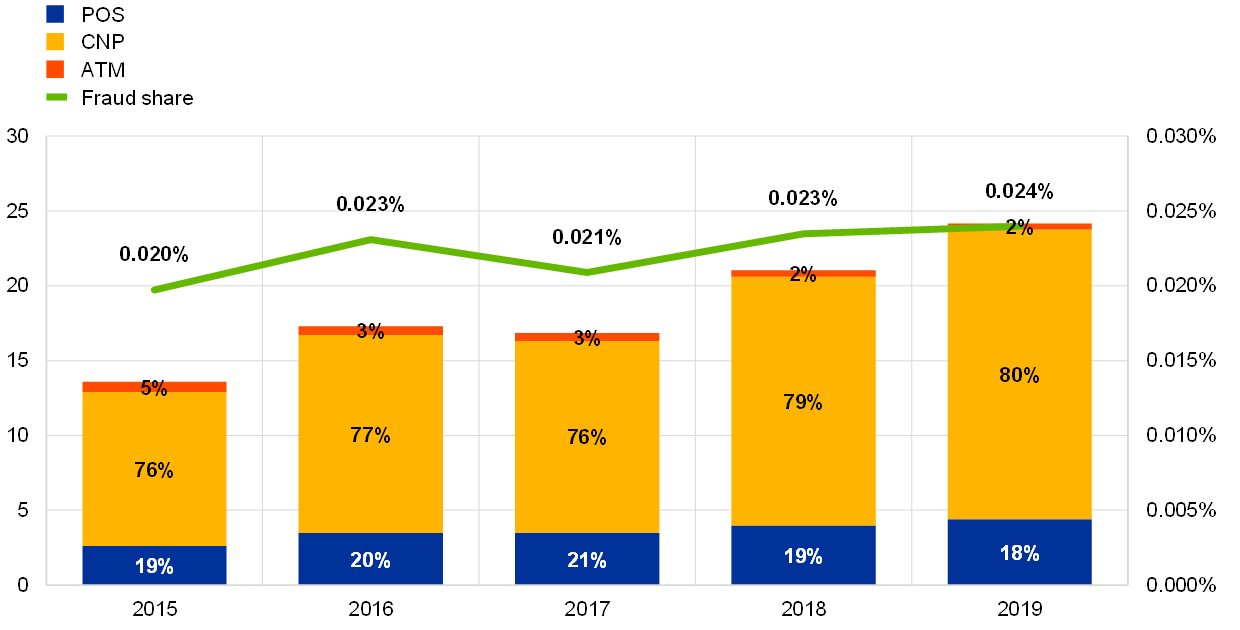
SL - Automated Driving Systems
Use labelled images to learn function from image to sign

SL - Property prediction
Use known molecules to learn function from structure to property value
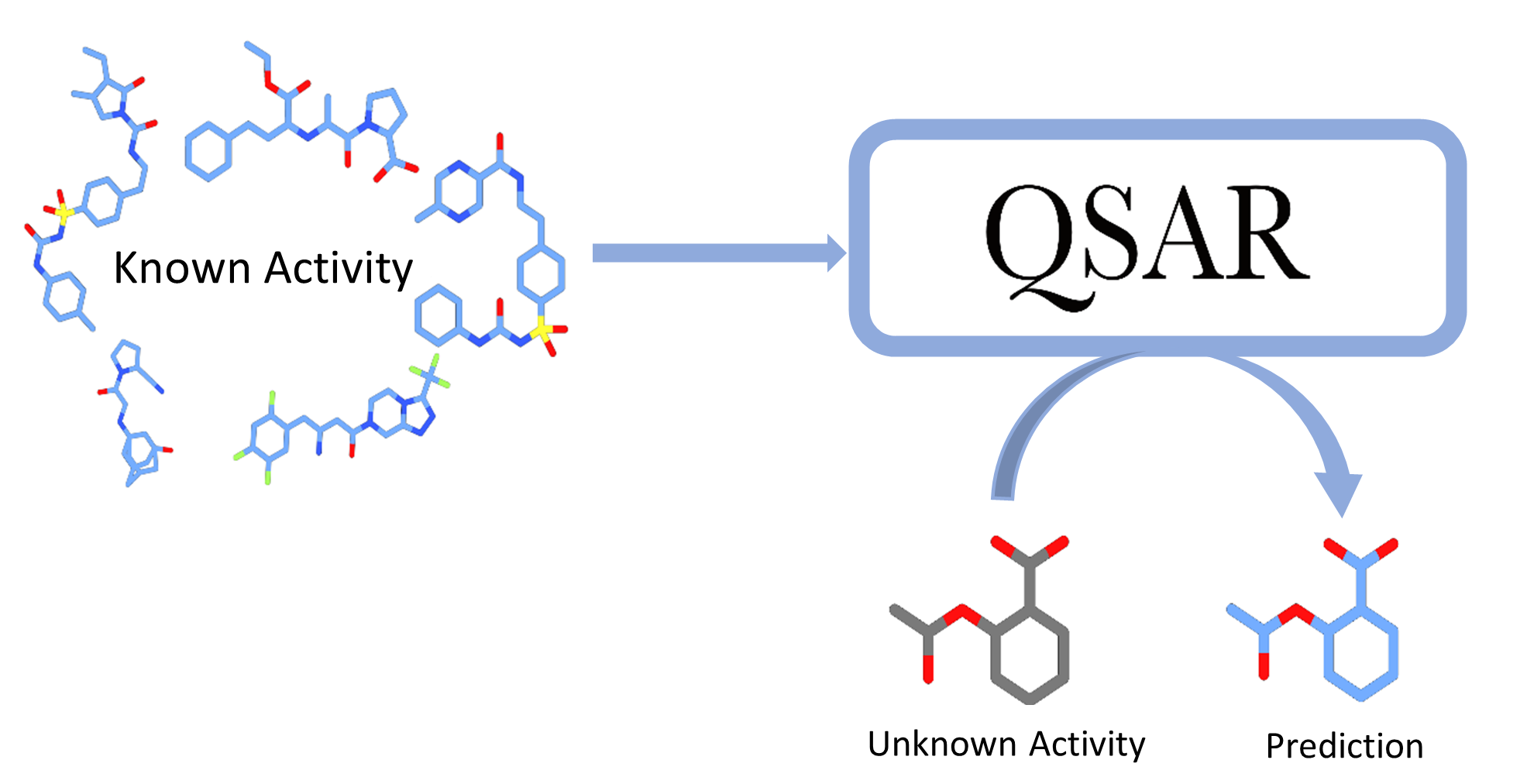
SL - How can we do it?
- We need to assume a parametric probabilistic model
\[ \pi_{w}( y \vert \boldsymbol{x}) \]
Use training data \(\mathcal{D} = \lbrace \boldsymbol{x}_i, y_i \rbrace_{i=1}^N\) to find best parameters \(w^*\)
Given new instance \(\boldsymbol{x'}\), output \(y\) with highest
\[ \pi_{w}( y \vert \boldsymbol{x'}) \]
Machine Learning - Learn?
A computer program is said to learn from experience E with respect to some class of tasks T and performance measure P, if its performance at tasks in T, as measured by P, improves with experience E.
— Source: Tom M. Mitchell
Supervised Learning - Ingredients
Labelled data: \(\mathcal{D}\) (Experience, Task)
Probabilistic Model: \(\pi_{w}( y \vert \boldsymbol{x})\) (Computer Program)
Training approach:
- Way to measure how good the model is (Performance)
- Adapt \(w\) to improve such performance
Example: linear regression
Data \(\mathcal{D} = \lbrace \boldsymbol{x}_i, y_i \rbrace_{i=1}^N\) where \(\mathcal{x}_i = (x_{i1}, x_{i2}, \dots, x_{ip})\)
Model:
\[ \pi_{w}( y \vert \boldsymbol{x}) = \mathcal{N}(w_1 x_{i1} + \dots w_p x_{ip}, \sigma) \]
Example: linear regression
Training approach:
Maximize likelihood given dataset \(\mathcal{D} = \lbrace \boldsymbol{x}_i, y_i \rbrace_{i=1}^N\)
\[ \max_{w_1, \dots, w_p}\prod_{i=1}^N \pi_{w}( y_i \vert \boldsymbol{x}_i) \]
Equivalent to minimizing sum-of-squares \[ \min_{w_1, \dots, w_p} \sum_{i=1}^N \left(y_i - \hat{y}_i \right)^2, ~~~~~ \hat{y}=w_1 x_{i1} + \dots w_p x_{ip} \]
Supervised Learning - Ingredients
Labelled data: \(\mathcal{D}\) (Experience, Task)
Probabilistic Model: \(\pi_{w}( y \vert \boldsymbol{x})\) (Computer Program)
Training approach:
- Way to measure how good the model is (Performance)
- Adapt \(w\) to improve such performance
General Training approach
Assume we have a probabilistic model \(\pi_{w}( y \vert \boldsymbol{x})\) and a training data \(\mathcal{D} = \lbrace \boldsymbol{x}_i, y_i \rbrace_{i=1}^N\)
Find \(w^*\) solving \[ \max_{w}\prod_{i=1}^N \pi_w( y_i \vert \boldsymbol{x}_i) \]
Same as minimizing negative log-likelihood
\[ L(\mathcal{D}, w) = \sum_{i=1}^N -\log \pi_{w}( y_i \vert \boldsymbol{x}_i) = \sum_{i=1}^N \ell (y_i, \boldsymbol{x}_i, w) \]
Training approach - Bias-Variance
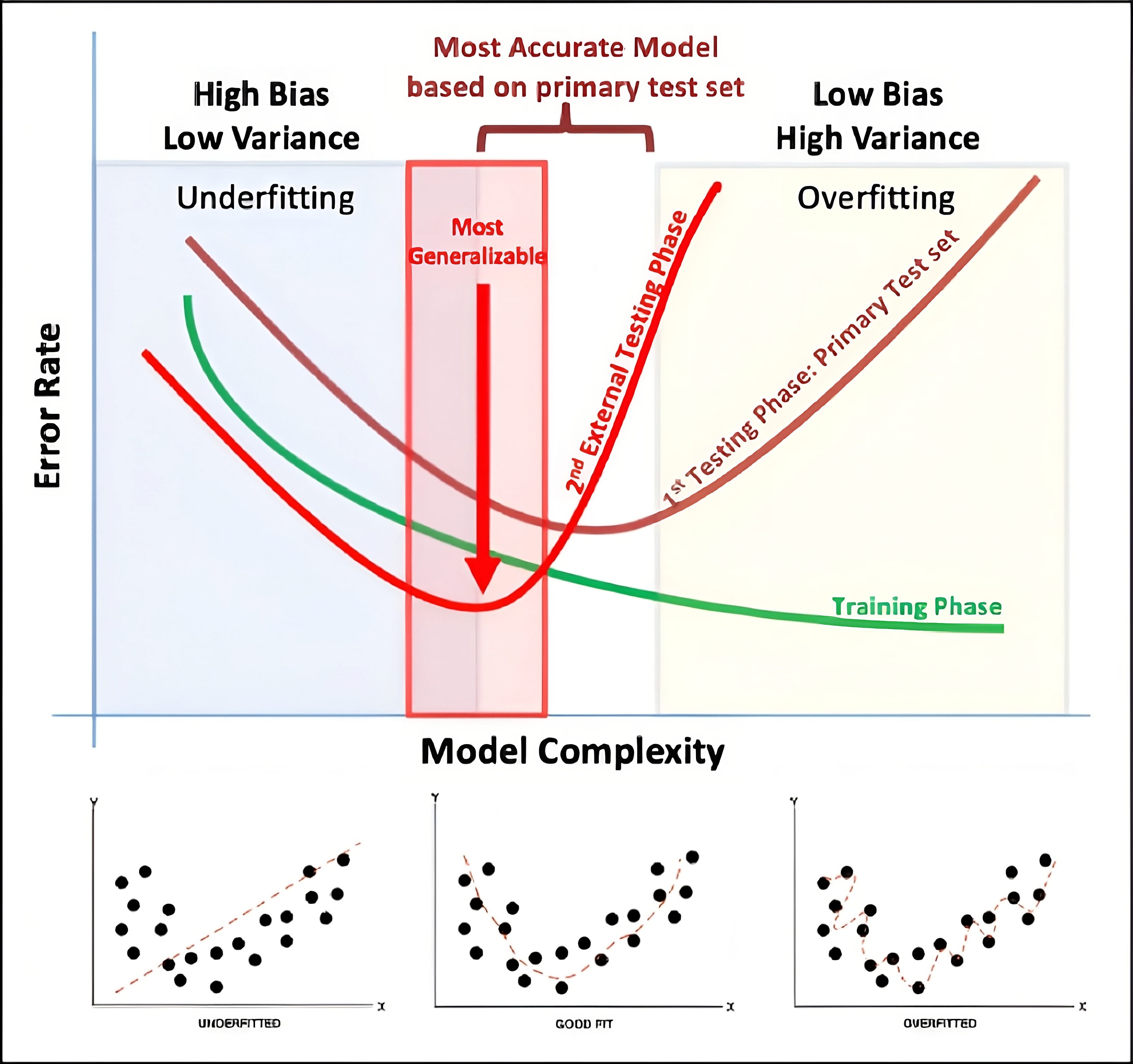
Training approach - Regularization
Many approaches to solve this:
Modify loss: \[ L(\mathcal{D}, w) = \sum_{i=1}^N \ell (y_i, \boldsymbol{x}_i, w) + \lambda \Vert w \Vert \]
More data
Modify the optimizer
Training approach - Optimizer
Once we have loss function, how to find \(w^*\)?
Analytically, almost never possible
Numerically! Gradient Descent: follow the gradient
\[ w_{t+1} = w_t - \eta_{t} \cdot \nabla_w L(\mathcal{D}, w) \]
Under some conditions, this converges to optimal \(w\)… or a good enough one
Training approach - Optimizer

Training approach - Optimizer
[Stochastic Gradient Descent] \[ \nabla_w L(\mathcal{D}, w) = \sum_{i=1}^N \nabla_w \ell (y_i, \boldsymbol{x}_i, w) \approx \nabla_w \ell (y_k, \boldsymbol{x}_k, w) \]
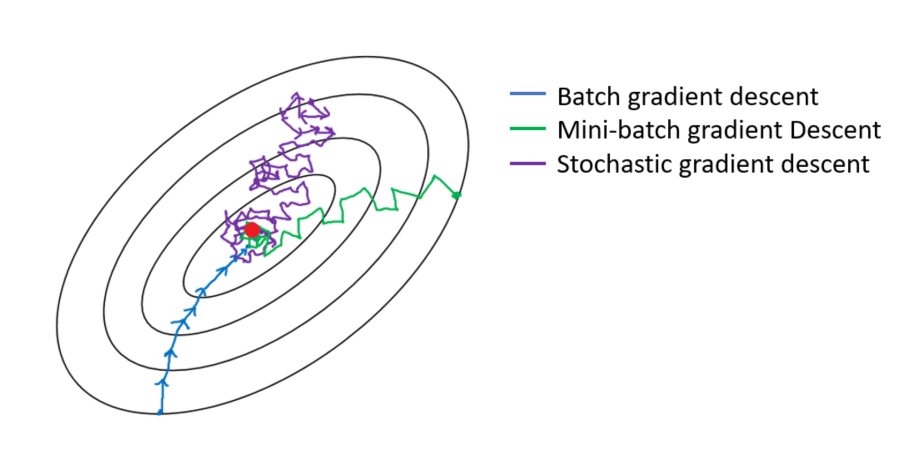
Supervised Learning - Ingredients
Labelled data: \(\mathcal{D}\) (Experience, Task)
Probabilistic Model: \(\pi_{w}( y \vert \boldsymbol{x})\) (Computer Program)
Training approach:
- Way to measure how good the model is (Performance)
- Adapt \(w\) to improve such performance
Probabilistic Model
The shape of \(\pi_{w}( y \vert \boldsymbol{x})\) determines the model. Some important cases:
Regression: \(y\in \mathbb{R}\) \[ \pi_{w}( y \vert \boldsymbol{x}) = \mathcal{N}(f_w(\boldsymbol{x}), \sigma) \]
Classification: \(y \in \lbrace 1, \dots, K\rbrace\)
\[\begin{eqnarray*} \pi_{w}( y = i \vert \boldsymbol{x}, w) &=& p_i(\boldsymbol{x}, w) \\ p_i(\boldsymbol{x}, w) &=& \frac{e^{f_w(\boldsymbol{x})_i}}{\sum_{j=1}^K e^{f_w(\boldsymbol{x})_j}} \end{eqnarray*}\]
Linear models
For linear models \(f_w(\boldsymbol{x}) = w_1 x_1 + \dots w_p x_p\)

Very unflexible!
Beyond linearity - Neural Nets
Single layer and single neuron

Beyond linearity - Neural Nets
Many layers and many neurons

Beyond linearity - Neural Nets
Neural Nets can in theory approximate any continuous function. [Innovative Models]
[Automatic Differentiation] allows computing the gradient of the loss wrt the parameters very efficiently (same complexity as evaluating the function)
\[ w_{t+1} = w_t - \eta_{t} \cdot \nabla_w \ell (y_k, \boldsymbol{x}_k, w) \]
Supervised Learning - Ingredients
Labelled data: \(\mathcal{D}\) (Experience, Task)
Probabilistic Model: \(\pi_{w}( y \vert \boldsymbol{x})\) (Computer Program)
Training approach:
- Way to measure how good the model is (Performance)
- Adapt \(w\) to improve such performance
Data
How to represent input data?
Tabular
Images
Text
Graphs
Data - Images
Represented as matrices, \(x_i\) corresponds to the intensity of the \(i\)-th pixel. ![]()
Data - Text
One hot encoding, \(x_i\) can take value 0 or 1. 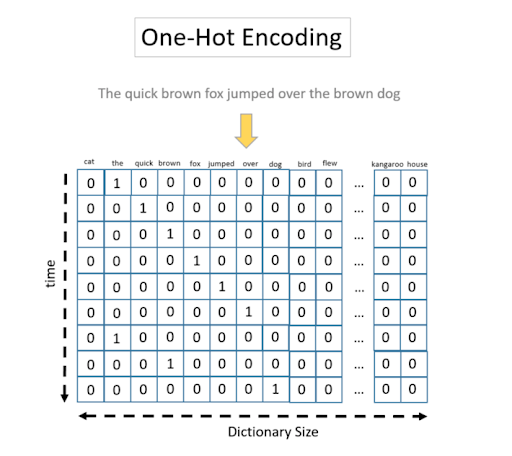
Data - More!
For instance graphs - Specific architectures (GNNs) 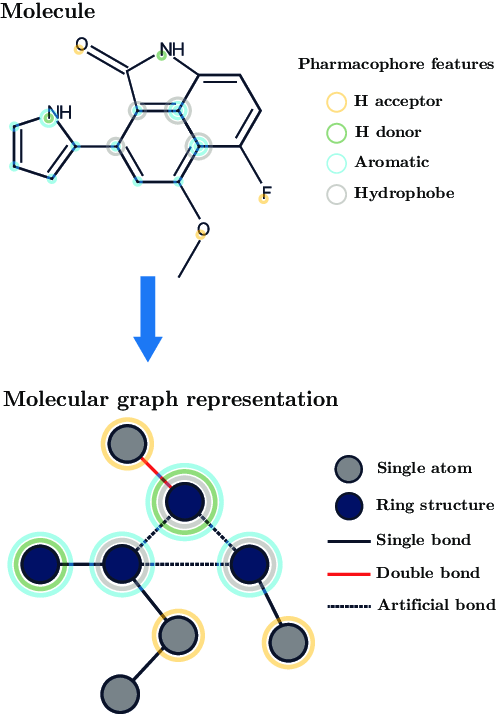
Data
Once images/text/graphs had been represented, rest of the procedure is the same:
Observed input-output pairs \(\mathcal{D} = \lbrace \boldsymbol{x}_i, y_i \rbrace_{i=1}^N\)
Choose a model \(\pi_{w}( y \vert \boldsymbol{x})\). This entails choosing \(f_w(\boldsymbol{x})\)
Choose a loss function \(L(\mathcal{D}, w)\)
Optimize to find \(w^*\): \(w_{t+1} = w_t - \eta_{t} \cdot \nabla_w L(\mathcal{D}, w)\)
Given new input \(\tilde{\boldsymbol{x}}\), predict using \(\pi_{w^*}( y \vert \tilde{\boldsymbol{x}})\)
Modern times - Self Supervision
We are very good (in general) in supervised learning problems
We need access to labelled \(\mathcal{D} = \lbrace \boldsymbol{x}_i, y_i \rbrace_{i=1}^N\)
Most data in the internet is unlabelled…
How can we create a supervised learning problem out of unlabelled data?
Modern times - Self Supervision
Remove parts of the data (this will be our outcomes)
Use the rest of data to predict the removed parts (features/inputs)
Modern times - GPT
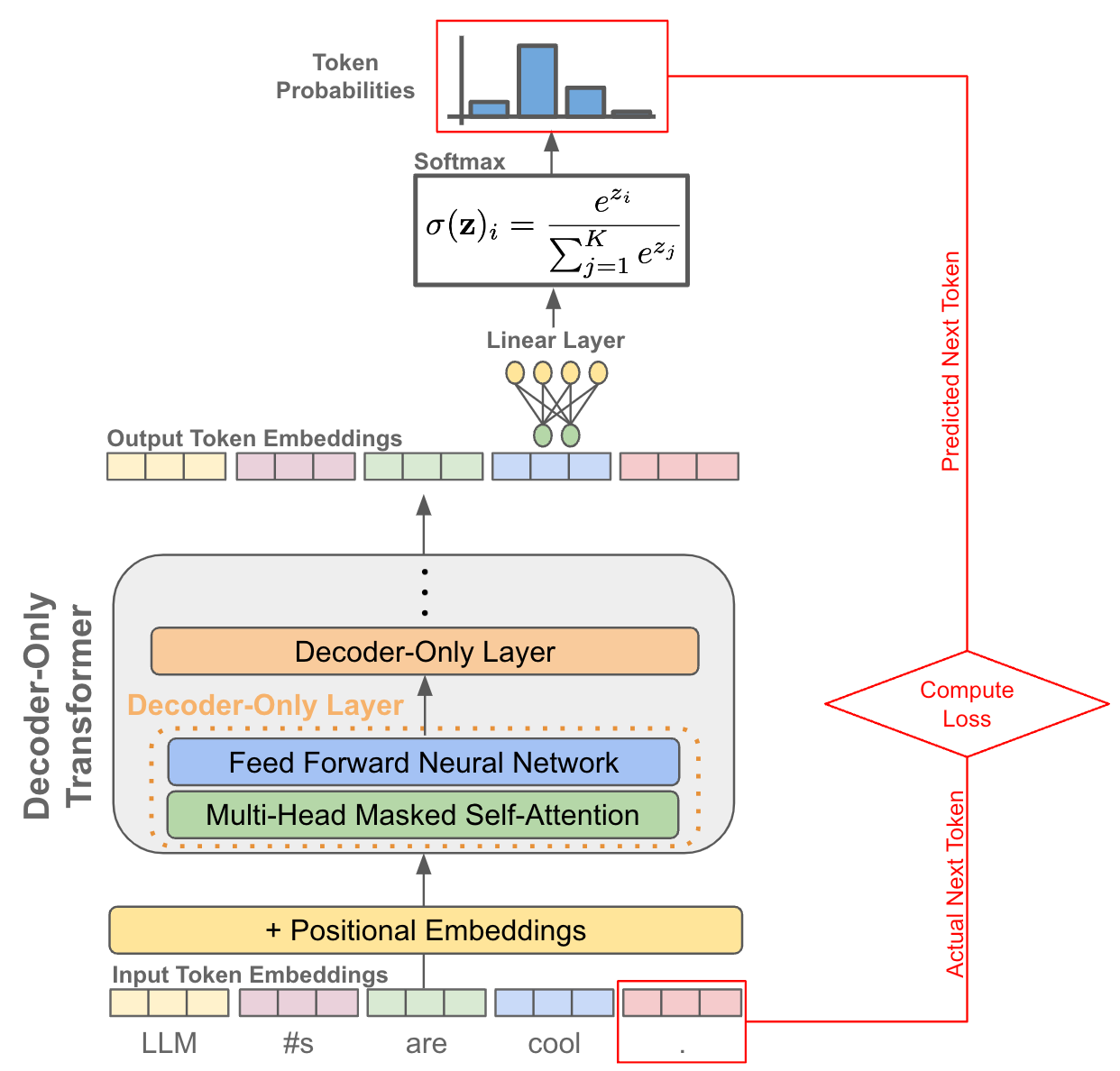
Some Random Thoughts
Access to advanced ML models democratized by frameworks like PyTorch
ML critically affects individual decision-making
Privacy? Democracy?
We are giving (very valuable data) for free!
LLMs might eliminate many technical jobs, but not all
- Safety, security?
4th Scientific Paradigm
Thank You!

